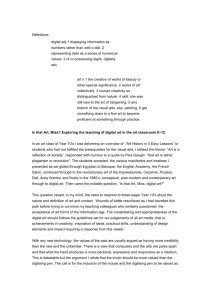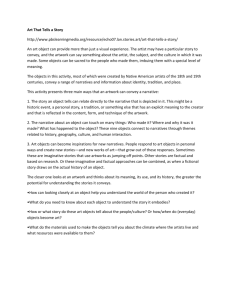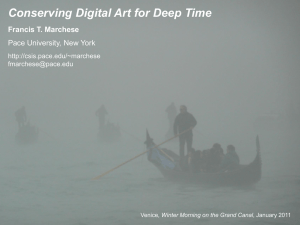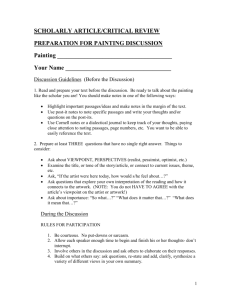High School Curriculum Map – Visual Art – Art 2D/3D
advertisement
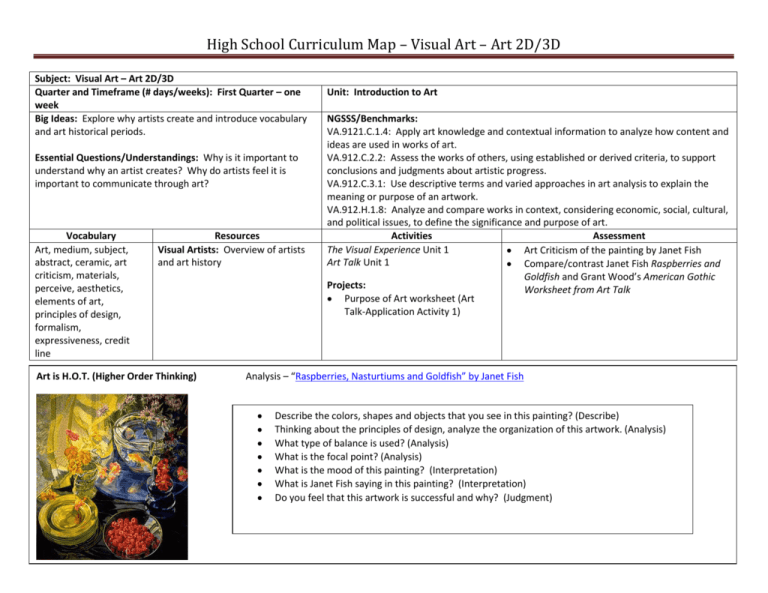
High School Curriculum Map – Visual Art – Art 2D/3D Subject: Visual Art – Art 2D/3D Quarter and Timeframe (# days/weeks): First Quarter – one week Big Ideas: Explore why artists create and introduce vocabulary and art historical periods. Essential Questions/Understandings: Why is it important to understand why an artist creates? Why do artists feel it is important to communicate through art? Vocabulary Art, medium, subject, abstract, ceramic, art criticism, materials, perceive, aesthetics, elements of art, principles of design, formalism, expressiveness, credit line Resources Visual Artists: Overview of artists and art history Art is H.O.T. (Higher Order Thinking) Unit: Introduction to Art NGSSS/Benchmarks: VA.9121.C.1.4: Apply art knowledge and contextual information to analyze how content and ideas are used in works of art. VA.912.C.2.2: Assess the works of others, using established or derived criteria, to support conclusions and judgments about artistic progress. VA.912.C.3.1: Use descriptive terms and varied approaches in art analysis to explain the meaning or purpose of an artwork. VA.912.H.1.8: Analyze and compare works in context, considering economic, social, cultural, and political issues, to define the significance and purpose of art. Activities Assessment The Visual Experience Unit 1 Art Criticism of the painting by Janet Fish Art Talk Unit 1 Compare/contrast Janet Fish Raspberries and Goldfish and Grant Wood’s American Gothic Projects: Worksheet from Art Talk Purpose of Art worksheet (Art Talk-Application Activity 1) Analysis – “Raspberries, Nasturtiums and Goldfish” by Janet Fish Describe the colors, shapes and objects that you see in this painting? (Describe) Thinking about the principles of design, analyze the organization of this artwork. (Analysis) What type of balance is used? (Analysis) What is the focal point? (Analysis) What is the mood of this painting? (Interpretation) What is Janet Fish saying in this painting? (Interpretation) Do you feel that this artwork is successful and why? (Judgment) High School Curriculum Map – Visual Art – Art 2D/3D Subject: Visual Art – Art 2D/3D Quarter and Timeframe (# days/weeks): First Quarter - 4 weeks Big Ideas: Identify and draw a variety of descriptive line, outlines and contour lines and to recognize the impact of line in art. Essential Questions/Understandings: How would changing the position and values of lines change the mood of an artwork? Vocabulary Line, descriptive line, outline, contour line, hatching, crosshatching, implied line, edge, lines of sight, expressive line, dimension Resources Visual Artists: Pablo Picasso Charles Schulz Alexander Calder Vincent Van Gogh Art is H.O.T. (Higher Order Thinking) Unit: Line NGSSS/Benchmarks: VA.912.S.1.1: Use innovative means and perceptual understanding to communicate through varied content, media and art techniques. VA.912.S.1.4: Demonstrate effective and accurate use of art vocabulary throughout the artmaking process. VA.912.S.2.3: Demonstrate visual thinking skills to process the challenges and execution of a creative endeavor. VA.912.O.1.1: Use the structural elements of art and the organizational principles of design in works of art to establish an interpretive and technical foundation for visual coherence. Activities The Visual Experience Unit 2, Chapter 3 Art Talk Unit 2, Chapter 4 Projects: Mirror name design Line as shape design. Make a picture emerge using a varied line design without any outlines around the images. (One line direction) Create Optical Movement – Curved line design (Op Art) Hide the clipping: Line drawing where lines can camouflage images 26 Adjectives (lines express emotion) 12 = 13: Lines can be made of images/shapes Assessment Individual project evaluation based on objectives of the project Art criticism of Keith Haring artwork. Art Criticism: “Untitled” by Keith Haring Describe the types of lines used in this artwork – look both at the foreground and the background. (Description) What is the most important art element in this artwork? (Analysis) What is he trying to communicate through the use of lines? (Interpretation) How successful was Keith Haring in creating a balanced composition? (Judgment) High School Curriculum Map – Visual Art – Art 2D/3D Subject: Visual Art – Art 2D/3D Quarter and Timeframe (# days/weeks): First Quarter - 4 weeks Big Ideas: Student will be able to perceive and understand the different types of shapes and forms. Essential Questions/Understandings: Why is it important the events of the time period and culture in order to understand the artwork? Vocabulary Shape, figure, ground, positive shape, negative shape, form, foreshortening, organic, geometric, closed, open Resources Visual Artists: Edward Hopper Pablo Picasso M. C. Escher Alice Neel Henry Moore Art is H.O.T. (Higher Order Thinking) Unit: Shape and Form NGSSS/Benchmarks: VA.912.F.1.1: Use divergent thinking, abstract reasoning, and various processes to demonstrate imaginative or innovative solutions for art problems. VA.912.H.2.5: Analyze artwork from a variety of cultures and times to compare the function, significance and connection to other cultures or times. VA.912.O.1.3: Research and use the techniques and processes of various artists to create personal works. VA.912.S.3.10: Develop skill in sketching and mark-making to plan, execute, and construct two-dimensional images or three-dimensional models. Activities Assessment The Visual Experience Unit 2, Chapter 4 Individual project evaluation based Art Talk Unit 2, Chapter 5 on objectives of the project Art criticism of Edward Hopper Projects: Figure- ground – tessellation Positive/negative designs Cubism: geometric designs 3-dimensional drawing with shading to create form. Analysis – “House by the Railroad” by Edward Hopper Why does the house in this painting seem heavy and closed? (Analysis) What do you see in this painting that you don’t see in the Naples area? How is this artwork organized? Discuss balance, horizontal and vertical shapes and forms? (Analysis) Is there any sense of a human presence? (Interpretation) What is the mood of this painting and as the artist been successful in conveying this feeling? (Judgment) High School Curriculum Map – Visual Art – Art 2D/3D Subject: Visual Art – Art 2D/3D Quarter and Timeframe (# days/weeks): Second Quarter – 9 weeks Big Ideas: Understand how artists vary hue, value, color, and intensity to create different effects. Essential Questions/Understandings: How does color contribute to the unity of an artwork? Can you identify an object if you don’t see the color? Explain Vocabulary Value, shading chiaroscuro, spectrum hue, primary colors, secondary colors, intermediate colors, complementary colors, monochromatic, intensity, color harmonies, warm colors, cool colors, tints, pigments, binders, solvents Resources Visual Artists: Claude Monet Pierre Auguste Renoir Vincent VanGogh Henri Matisse, Art is H.O.T. (Higher Order Thinking) Unit: Value and Color NGSSS/Benchmarks: VA.912.S.3.8: Develop color-mixing skills and techniques through application of the principles of color and light theory. VA.912.S.2.6: Incorporate skills, concepts and media to create images from ideation to resolution. VA.912.C.1.4: Apply art knowledge and contextual information to analyze how content and ideas are used in works of art. Activities Assessment The Visual Experience Unit 2, Chapter 5 Individual project evaluation based on Art Talk Unit 2, Chapter 6 objectives of the project Introduction of a variety of media: watercolor, Compare/contrast Monet- Van Gogh tempera, oil pastel, chalk pastel, colored pencils paintings Projects: Creative Color Wheel design Value study – cutting values from magazines/painting Impressionistic painting Monochromatic painting Color harmony project Compare/Contrast: “Impression Sunrise” by Claude Monet and “Starry Night” by Vincent Van Gogh Both of these paintings are landscapes from the Impressionist period, describe how they differ? How are these paintings similar/different in use of color and line? (Analysis) What is the focal point? (Analysis) Can you identify a color scheme? (Analysis) If you had to own one, which one would you choose and why? High School Curriculum Map – Visual Art – Art 2D/3D Subject: Visual Art – Art 2D/3D Quarter and Timeframe (# days/weeks): Third Quarter – 4 weeks Big Ideas: Identify and discuss ways artists create the appearance of space and depth in two-dimensional artworks by identifying horizon lines, vanishing points and converging lines. Essential Questions/Understandings: What is your perspective on perspective? Vocabulary Resources Positive space, negative Visual Artists: space, picture, plane, Renaissance artists: overlapping, high-low Leonardo daVinci placement, linear Raphael perspective, vanishing M. C. Escher point, one-point Georgia perspective, two-point Frank Lloyd Wright perspective, eyelevel, aerial perspective, framing Art is H.O.T. (Higher Order Thinking) Compare/contrast Unit: Space NGSSS/Benchmarks: VA.912.S.2.2: Focus on visual information and processes to complete the artistic concept. VA.912.S.3.1: Manipulate materials, techniques, and processes through practice and perseverance to create a desired result in two-and/or three-dimensional artworks. VA.912.H.1.9: Describe the significance of major artists, architects, or masterworks to understand their historical influences. Activities The Visual Experience Chapter 6, Art Talk Unit 2, Chapter 5 Projects: One-point perspective drawing Two-point perspective drawing interior/exterior Choice of perspective drawing Discussion of careers Assessment Individual project evaluation based on objectives of the project Compare/contrast a Middle Ages artwork with a Renaissance artwork Très riches heures du Duc de Berry: by the Limbourg Brothers with the School of Athens by Raphael Compare/contrast the color and space in these two artworks? What dominates the space in each of the compositions and why? (Analysis) What is the story behind each of these paintings? What is the mood of these paintings and are they similar? (Interpretation) How does the perspective provide a new way of seeing the subject matter? High School Curriculum Map – Visual Art – Art 2D/3D Subject: Visual Art – Art 2D/3D Quarter and Timeframe (# days/weeks): Fourth Quarter – 1 week Big Ideas: The students will explore the development of artistic styles through time. Essential Questions/Understandings: How does the passing of time and events affect the artist’s creations? Vocabulary Resources Illuminated Visual Artists: manuscripts Michelangelo Relics Raphael Calligraphy Leonard da Vinci Donatello Donald Jackson Unit: Art History – Western Art – Middle Ages, Renaissance, and High Renaissance NGSSS/Benchmarks: VA.912.H.2.5: Analyze artwork from a variety of cultures and times to compare the function, significance and connection to other cultures or times. VA.912.O.1.3: Research and use the techniques and processes of various artists to create personal works. Activities Assessment The Visual Experience Chapter 15 Individual project evaluation based on objectives of the project Projects: Create an illuminated manuscript around your own poem Art is H.O.T. (Higher Order Thinking) Art Criticism: St. John’s Bible by Donald Jackson compared to the French Books of Hours Describe the immediate differences/similarities that you see in these illuminated manuscripts. (Describe) Identify the color schemes in each. (Analysis) Describe the type of space used. (Describe) High School Curriculum Map – Visual Art – Art 2D/3D Subject: Visual Art – Art 2D/3D Quarter and Timeframe (# days/weeks): Third Quarter – 1 week Big Ideas: Students will perceive and create texture in the environment and in artworks. Essential Questions/Understandings: Generally, uniform use of textural pattern and invented texture results in relatively shallow space. Is this true or not? Explain Vocabulary Gloss, matte, actual texture, simulated texture, invented textures, rubbings, collage Resources Visual Artists: Dorothea Lange Robert Rauschenburg Edouard Manet Deborah Butterfield Art is H.O.T. (Higher Order Thinking) Unit: Texture NGSSS/Benchmarks: VA.912.C.1.5: Analyze how visual information is developed in specific media to create a recorded visual image. VA.912.C.2.7: Assess the challenges and outcomes associated with the media used in a variety of one’s own works. VA.912.S.3.1: Manipulate materials, techniques, and processes through practice and perseverance to create a desired result in two-and/or three-dimensional artworks. Activities The Visual Experience Unit 2, Chapter 7 Art Talk Unit 2, Chapter 7 Projects: Create a crossover artwork using both actual and simulated textures Texture Collage Simulated texture using hatching, cross-hatching and stippling Assessment Individual project evaluation based on objectives of the project Analysis of painting by Edouard Manet Art Criticism: “Oysters” by Edouard Manet Describe the textures you see in this painting? (Describe) What do you think is the center of interest and why? (Analysis) How does the artist create a feeling of space? (Analysis) Can you identify a color scheme? (Analysis) How does the artist use chiaroscuro in this painting? (Analysis) This is an early work which was found in Manet’s studio at the time of his death. What reasons might a highly successful artist have for keeping a particular work in his possession? (Judgment) High School Curriculum Map – Visual Art – Art 2D/3D Subject: Visual Art – Art 2D/3D Quarter and Timeframe (# days/weeks): Third Quarter – 1 week Big Ideas: The student will understand how artists use the principles of design to create an artwork. Essential Questions/Understandings: How does the artist use the principles of design as a recipe to create a piece of artwork? Vocabulary Unity, variety, emphasis, rhythm, movement, balance, pattern, proportion Resources Visual Artists: Andrew Wyeth Grant Wood Andy Warhol Richard Estes Edward Hopper Art is H.O.T. (Higher Order Thinking) Unit: Principles of Design NGSSS/Benchmarks: VA.912.O.1.1: Use the structural elements of art and the organizational principles of design in works of art to establish an interpretive and technical foundation for visual coherence. VA.912.S.3.2: Demonstrate a balance between spontaneity and purpose to produce complex works of art with conviction and disciplined craftsmanship. Activities Assessment The Visual Experience Unit 2, Chapter 8 Individual project evaluation based on Art Talk Unit 3, Chapter 8 objectives of the project Analysis of painting by Richard Estes Projects: Overview of the Principles of Design Non-objective artwork showing focal point using variegated gray papers Analysis: “Drugstore” by Richard Estes Describe how the artist uses the principles of design. (Description) Is this symmetrically or asymmetrically balanced and why? (Analysis) How does the lighting show the time of day and how does this affect the mood of the painting? Is there rhythmic line and where? (Analysis) How long do you think it took the artist to create this painting? If the “S” was not on the diagonal, would that affect the feeling of this painting? (Interpretation) High School Curriculum Map – Visual Art – Art 2D/3D Subject: Visual Art – Art 2D/3D Quarter and Timeframe (# days/weeks): Third Quarter – 3 week Big Ideas: Students will recognize and understand the processes and techniques used in two-dimensional media. Essential Questions/Understandings: Can an artist choose a medium and a technique to create different moods in an artwork? Vocabulary Height, width, medium (media), drawing, painting, printmaking, photography, film, video art, computer art, mixed media Resources Visual Artists: Joseph Stella Mary Cassatt Albrecht Durer Annie Liebowitz Anne Geddes Unit: Two-Dimensional Media Sunshine State Standards/Benchmarks: VA.912.H.3.3: Use materials, ideas, and/or equipment related to other content areas to generate ideas and process for the creation of works of art. VA.912.F.1.4: Use technological tools to create art with varying effects and outcomes. VA.912.S.2.6: Incorporate skills, concepts and media to create images from ideation to resolution. Activities Assessment The Visual Experience Unit 3, Individual project evaluation based on Chapter 9 objectives of the project Analysis of film compared to painting Projects: Trompe l’oeil in value study Figure Study Color mixing Creating visual movement through printmaking Mural painting Art is H.O.T (Higher Order Thinking) Teacher choice of film: (District approved) Students will analyze the film using the elements of art and the principles of design. Compare the use of the elements and principles to artworks that use paint. For example, in Casablanca, if they used the same texture of clothing in every background, there would be no contrast. High School Curriculum Map – Visual Art – Art 2D/3D Subject: Visual Art – Art 2D/3D Quarter and Timeframe (# days/weeks): Fourth Quarter – 1 week Big Ideas: Students will recognize and identify 3-D art forms. Essential Questions/Understandings: Thinking about 3dimensional artwork, what other materials can you imagine being used in the future to create 3-dimensional art? What are the obstacles that you have to overcome when creating a three-dimensional work of art compared to a two-dimensional work of art? Vocabulary Resources Sculpture, relief Visual Artists: sculpture, Dale Chihuly conceptual art, Louise Nevelson performance art, Henry Moore environmental art, Christo installation art, George Segal fiber art, soft Rodin sculpture, Claes Oldenburg assemblages Unit: Three-Dimensional Media Sunshine State Standards/Benchmarks: VA.912.C.1.2: Use critical-thinking skills for various contexts to develop, refine and reflect on an artistic theme. VA.912.S.3.1: Manipulate materials, techniques, and processes through practice and perseverance to create a desired result in two-and/or three-dimensional artworks. VA.912.S.3.7: Use and maintain tools and equipment to facilitate the creative process. VA.912.S.3.3: Review, discuss and demonstrate the proper applications and safety procedures for hazardous chemicals and equipment during the art-making process. Activities Assessment Lessons: The Visual Experience Unit 3, Individual project evaluation based on Chapter 9 objectives of the project Projects: Found sculpture (Louise Nevelson) River Stone Sculpture Garden Plaster sculpture Art is H.O.T. (Higher Order Thinking) Compare/contrast the “Vietnam Wall” by Maya Lin to Persian Wall Installation by Dale Chihuly Describe the organic and geometric shapes/forms. (Describe) What has each artist done to create the feeling of rhythm in each artwork? (Analysis) Based on your knowledge of these artworks, list some ideas or feelings you associate with it? (Interpretation) What does this remind you of? (Interpretation) How well does the work relate to the site, its surroundings, the natural elements and changing seasons? (Judgment) High School Curriculum Map – Visual Art – Art 2D/3D Subject: Visual Art – Art 2D/3D Quarter and Timeframe (# days/weeks): Fourth Quarter – 1 week Big Ideas: Students will become familiar with the wide range of careers in art. Essential Questions/Understandings: What are the differences between a fine art career and a design career? Make a list of every facet of your life that is touched by an artist? Vocabulary Gaming design, computer design, environmental design, communications design, web artist, illustrator, multimedia design, photographer, animator, photojournalist, art director, curator, conservator Resources Visual Artists: Mercer Mayer Ollie Johnston Frank Lloyd Wright, Unit: Careers NGSSS/Benchmarks: VA.912.F.2.1: Examine career opportunities in the visual arts to determine requisite skills, qualifications, supply-and-demand, market location, and potential earnings. VA.912.F.2.6: Develop a personal artist statement, resume, presentation, or digital portfolio to interview of an art-related position or exhibition. Activities The Visual Experience Unit 3, Chapter 12 Art Talk Chapter 14 Projects: Guest speaker to speak about his/her career in art. Students create critical questions to interview the artist Research a famous illustrator or someone in the art field and an artwork mimicking the style Field trips to local museums and interview the curator, education director, etc. Internship with a local artist. Assessment Individual project evaluation based on objectives of the project High School Curriculum Map – Visual Art – Art 2D/3D Subject: Visual Art – Art 2D/3D Quarter and Timeframe (# days/weeks): Fourth Quarter – 1 week Big Ideas: Non-western cultures represent a wide variety of peoples, geography, history and beliefs. Essential Questions/Understandings: As you explore nonWestern artworks, what similarities/differences do you find in the organization of the artwork? Vocabulary Resources Artforms from: Visual Artists: China Tokan Shugetsu Japan Utagawa Hiroshige Africa Sim Sajong India Oceania Native North and South America Unit: Art History – Non Western Art I and II Sunshine State Standards/Benchmarks: VA.912.H.1.1: Analyze the impact of social, ecological, economic, religious, and/or political issues on the function or meaning of the artwork. VA.912.H.1.10: Describe and analyze the characteristics of a culture and its people to create personal art reflecting daily life and/or the specified environment. Activities The Visual Experience Unit 4, Chapter 13 Art Talk Unit 4, Projects: Asian tub – demonstrate Sumi’e painting Using the techniques of Sumi’e, create a landscape Create a mandala Japanese Woodcuts/printmaking Assessment Individual project evaluation based on objectives of the project

